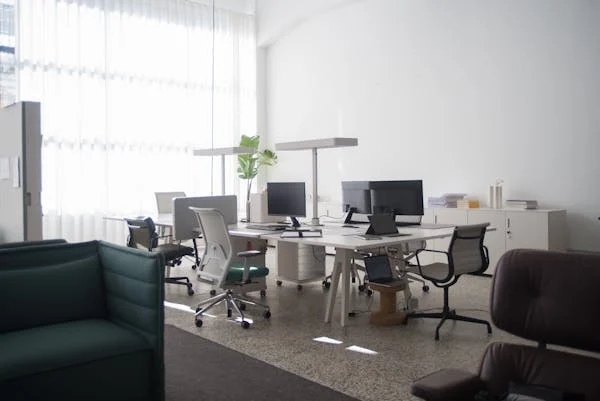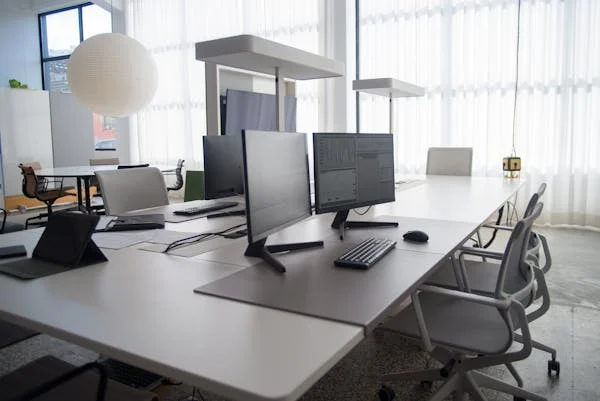
Table of Contents
ToggleErgonomic Desk Solutions for Home Workers: 7 Essential Tips for Comfort and Productivity
As extra human beings transition to working from domestic, it is vital to create a comfortable workspace that enables saving pressure and maximizes productivity. Whether remote, freelancer or simply needing a relaxed working environment, ergonomic desk solutions can help make day-to-day life more comfortable and prevent long-term health issues from developing. A good setup is not just about supporting our physical health but also about improving our mental focus. This article discusses seven important tips for setting up an ergonomic workspace that is comfortable and conducive to productivity.
Home Office Ergonomics: Your Guide to Work from Home Comfort and Health
With remote work and home offices, more people are working long hours in front of computers. Unfortunately, most employees working from home tend not to think much about ergonomics while setting up their workspace, resulting in discomfort and potential injury. Ergonomics is about tailoring a workspace to promote comfort, productivity, and health by customizing furniture, equipment, and posture for the needs of the individual. It’s about establishing a configuration that works with your body’s natural movements to work efficiently without straining your muscles, joints, or eyes.
When home is the work site, it’s simple to forget how important a well-designed workspace can be to overall health. Old ergonomic practices create chronic problems like back pain, eye strain, or repetitive stress injuries. Ensuring your home office is ergonomic can go a long way to enhance comfort and create an environment conducive to focus and productivity. A proper ergonomic desk solution considers posture, movements, and equipment layout—giving everyone a healthier and more sustainable work environment.
The Rise of Remote Work and Its Impact on Ergonomics
When transitioning towards remote work, it is most important that we invest in an ergonomic desk setup. With increasingly flexible work-from-home policies being embraced by many companies, more employees are now using long hours at home, often in prime environments that were never designed to be a full-time workspace. This has led to massive musculoskeletal issues among remote workers, which are back, neck, and wrist problems. Studies indicate that poor ergonomics in the home office are closely linked to such prevalent problems since many lack the ergonomic furniture and setups that workplaces offer.
Home workers are vulnerable to discomfort and repetitive stress injuries without a proper ergonomic desk setup. Improvised workstations, such as kitchen tables or couches, can cause bad posture and chronic pain. 2 Invest in Ergonomic Furniture — Furniture such as an adjustable desk and an ergonomic chair should be investment pieces as they are key to good posture that reduces strain and increases productivity. Ergonomics is meant to preserve your long-term health to function at peak performance levels.
What is Ergonomics, and Why is it Important?
Ergonomics is the science of designing a workspace according to the worker’s needs. The concept involves arranging furniture, equipment, and posture to foster an environment where comfort, safety, and efficiency are encouraged. Ergonomics is most commonly known about physical comfort, but it also significantly reduces mental burden and enhances productivity.
Designing an ergonomic workstation decreases the chance of discomfort and injury, enhancing health and performance. Poor ergonomic setup can lead to headaches, muscle tension, eye strain, and more. Ergonomics is a must-have for home workers, helping to transform conditions that might not be perfect into an environment conducive to physical well-being and work productivity. So, ultimately, ergonomics makes your surroundings more comfortable and optimized for productivity!
Components of an Ergonomic Workstation
Keys to Building the Ergonomic Desk Setup of Your Dreams It’s not solely about the best desk or chair but also how all elements mesh to make you a comfortable, productive workspace. Ultimately, you aim to ease tension in your body while making you feel more relaxed and productive.
The key components are an adjustable chair with lumbar support, a desk that lets you properly position your computer and other peripherals, and the right arrangement of your keyboard, mouse , and monitor. A balance of all these should help you stay in good posture and be able to do tasks without discomfort. A carefully designed ergonomic workspace is vital for long-term health and avoiding work-related injuries. Focusing on these eight critical components helps you create a physical space that promotes your mental health and motivates you to work.

Height and Adjustability of Ergonomic Desk
One of the most vital elements of an ergonomic desk is the proper height. The desk should be located so that while you’re typing, your elbows remain at a ninety-degree perspective, together with your forearms parallel to the ground. If the table is too excessive or too low, it may result in stress on your shoulders, hands, and wrists, inflicting pain and potentially leading to repetitive stress accidents over the years.
Take a seat-stand; adjustable desks are top-notch for building a flexible workspace. According to experts, if you spend long periods seated at a desk, you can reduce the strain of remaining in the same position for too long by opting for a desk where you can alternate between sitting and standing. Alternating between standing and sitting while working helps take pressure off the spine, aid circulation, and increase energy levels. An adjustable desk allows you to customize the height to fit your body so you can office comfortably with less chance of discomfort from long work hours.
The Chair Selection: The Support And Comfort
The most crucial component of an ergonomic setup is your chair. It should provide firm lumbar support that maintains your lower back in a neutral position while helping to minimize the muscle fatigue that can arise from sitting for extended periods. An ergonomic chair does a good job of keeping the spine’s natural curve in alignment.
Aside from lumbar support, your chair should be highly adjustable to set the seat height, backrest angle, and armrests to your body. Hours spent in a chair that lacks support can contribute to back pain, circulation issues, and general discomfort. Invest in a good, ergonomic posture-supporting chair that encourages movement to prevent long-term health complications. Comfort and support can make or break an ergonomic workstation, so it’s worth investing in a chair that gets the job done.
Mouse & Keyboard Placement
Proper mouse and keyboard placement helps minimize strain while working for long hours. Your keyboard should sit at a height that allows your arms to form a 90-degree angle while typing. This ensures you don’t overextend your shoulders or wrists. Keeping the keyboard too high or too low will cause discomfort and can lead to repetitive strain injuries over time.
The mouse should be equally placed with the keyboard; however, it should be within easy access, so you don’t need to stretch your arm out awkwardly. If your mouse is too far or at an uncomfortable angle, it can lead to shoulder and wrist strain. Using a wrist rest to minimize the stress on your wrist when typing or using the mouse to reduce the risk of injury is often advisable. Such a small change can greatly enhance your comfort and help you avoid soreness after spending 8+ hours at the computer.
Monitor Positioning and Screen Height
The appropriate placement of the monitors is a very important factor in getting your neck in a neutral orientation and minimizing stress on the neck. Your monitor should be at eye level — you shouldn’t have to constantly look down or tilt your head to see the screen. If you’re perpetually craning your neck, this can cause pain and discomfort in your neck and shoulders. Generally, the top of the monitor screen must be at or slightly above your eye level so that you don’t need to raise your neck while working.
Your distance to the screen matters, too. Your monitor should be about an arm’s length away so you can minimize eye strain and enjoy a comfortable viewing angle. The appropriate screen height and distance help prevent neck and shoulder pain and facilitate your working comfort throughout the day.
Ergonomic Desk Solutions for Work-at-Home Workers
A well-designed workspace starts with investing in quality ergonomic furniture and accessories. As remote work becomes more prevalent, furnishing your home office with the right ergonomic gadgets is essential. Whether you’ve opted for a sit-stand desk or need to inject some ergonomics into your office chair, these solutions will make a difference in your comfort (and productivity) levels. Let’s explore some of the best ergonomic desk options on the market today to help ensure your workspace supports your long-term health and well-being.

Sit-Stand Desks
Sit-stand desks are becoming more popular in home offices. These desks let you alternate between sitting and standing, and they have several benefits for those working from home. Changing positions throughout the day can help with circulation and fatigue and may help you avoid musculoskeletal issues such as back pain and stiffness. This adaptability is crucial to keep spirits and comfort (#couch) up during long work hours.
Raising and lowering your desk’s height encourages you to move around, which is important in combating the negative effects of sitting for long durations. Either way, if you use a sit-stand desk, you can customize your work environment to suit your needs — stand for part of the day or boost your height for a better sitting angle. This ergonomic solution is an excellent way to develop a healthier, more active work routine conducive to physical and psychological wellness.
Ergonomic Office Chairs for Those Working from Home
This is only the tip of the iceberg, but an ergonomic office chair is one of the key investments when creating your home office. Not only do these chairs provide you comfort while spending hours sitting in one place, but they also provide support to your body to reduce the strain built up while staying seated so long. Look for an adjustable height, adjustable lumbar support, or adjustable armrests when selecting a chair. These modifications allow you to tailor the chair to your body’s specific needs and promote good posture throughout the day.
A good ergonomic chair maintains the natural curve of your spine, relieving pressure on your hips and lower back. Moreover, it is designed to keep you in a neutral sitting position, eliminating slouching and alleviating discomfort. When you opt for an ergonomic office chair that supports you where it matters, you’re setting yourself up for long-term comfort and avoiding the chronic pain associated with most seating arrangements.
Monitor Stands And Arms With Different Height Adjustments
Good posture is largely dependent on the placement of your monitor. Adjustable monitor stands and arms let you set your screen at the right height and angle, and doing so can reduce neck and eye strain substantially. These stands allow you to position your monitor at eye level, so you don’t have to hunch or crane your neck up, which can lead to neck pain over time.
Others can also tilt and rotate or switch from portrait to landscape mode, useful for writing or reading. This helps adjust the perfect viewing angle while working on documents, coding, or browsing the web. By keeping your eye level with your display, a correctly adjusted monitor can minimize the physical discomfort seen with improper angles and allow you to work for longer, with little to no pain.
Creating An Ergonomic Home Workstation
You now know the key ergonomic ingredients, so it’s time to assemble them all! Putting together a functional at home requires more than buying the best furniture; it also means arranging your surroundings to promote comfort and efficiency. A home office tailored to support your body’s needs will create a more productive and healthier work environment.

Desk Organization: It Sets You Up For Success
A messy desk can become stressful, so put your attention on your desk as it was clogged up very quickly. The first step for an ergonomic home office is to keep your workspace organized. Minimalism is the game’s name, with drawers, organizers, and shelves storing the essentials. Limit work to the ground only──keep only what you need to get your work within eyesight or to reach, and the rest out of view and out of mind to mitigate distractions.
It isn’t only mental clarity that comes from keeping a tidy desk—it also helps to hone your focus and productivity. By creating an organized workspace, you can reduce the time you spend looking for things and instead focus on doing your job. When you keep your desk functional (and clutter-free), you’re setting yourself up for success.
How to Optimize Your Work Environment for Comfort
The desk and chair are the first steps in setting up ergonomically, but other environmental elements also affect comfort. Lighting is a big factor when it comes to eye strain. The desk should, ideally, be placed near windows and natural light to elevate mood and productivity. Invest in task lighting to reduce glare and make your workspace more pleasant if that’s impossible.
How your room is set up is another important thing to consider. Desk: Set your desk for good posture and movement. Make sure your workspace permits regular, comfortable movement between sitting and standing. A neat, ergonomic room adds trust, position, and output full-bloomers.
Ergonomic Desk Setup: Avoid These Common Mistakes
A common error is desk and chair height. Incorrect desk or chair height can cause stress on your shoulders, back, and wrists. Use an adjustable desk chair with flat feet on the floor and knees at a 90-degree angle. The right desk height for all of your body parts would need to have you able to type while keeping your elbows at 90 degrees.
Proper lighting and screen positioning are other common mistakes. If your monitor isn’t positioned correctly, it can lead to neck pain. Position your screen at eye level, and adjust lighting to cut glare. Proper lighting will help prevent eye strain and keep energy levels up throughout your days.
Finally, many home workers aren’t getting regular exercise and breaks. Prolonged sitting can lead to stiffness and discomfort. Every hour, rote the same activity by standing, stretching, or walking to ease circulation and discomfort.
Desk and Chair Height Incorrect
One of the most unusual ergonomic mistakes whilst setting up a home workplace is failing to efficiently alter the desk and chair heights. in case your table is simply too excessive or too low, it forces your frame into awkward positions, leading to pressure on your back, neck, and wrists. When your table is too excessive, your shoulders may elevate, causing tension in your neck and return.
If it’s too low, you would possibly have to stoop ahead, increasing the danger of negative posture and pain. Ensure your chair is prepared so your toes are flat on the ground and your knees are at a 90-diploma attitude. This enables you to keep the right and decreases pressure on your lower again.
Ergonomic desk solutions for home workers include adjustable desks or desk chairs with multiple height adjustments. This slight change affects your health, well-being , and productivity.
Bad Lighting and Improper Screen Placement
Not using proper lighting and screen position makes up some other serious ergonomic errors. Lighting that is too dim or harsh can cause eye strain, headaches, and fatigue in your home office. Ideally, your screen should be angled so that it’s not reflecting light from windows or overhead lamps. Position your desk near a natural light source but out of direct sunlight, which can reflect on your screen or cause glare. If there’s a limit on natural light, task lighting or a desk lamp with adjustable brightness will help reduce eye strain and hone your focus.
As with desk placement, where you put your monitors is key to reducing neck and eye strain. Your monitor should be at eye level so you don’t have to tilt your neck, peering up and down at the screen. For an ergonomic configuration, your screen should be approximately arm’s length away, and the top of the monitor should be level with or just below your line of sight. This alignment reduces strain on the neck and shoulder muscles, which is key for any home worker spending hours sitting in front of a monitor.
I wonder who falls under Regular Movement and Breaks
One of the most frequent mistakes in home office ergonomics is prolonged sitting without breaks. Sitting for long periods can cause stiffness, reduced blood circulation, and irritation, especially in the lower back, hips, and legs. Ergonomic office solutions for homeworkers should promote regular movement. Your body needs a moment to stretch and reset, even with an ergonomically well-set-up desk. Every 30 to 60 minutes, get up, stretch, or walk around. This takes pressure off your spine and joints and helps you to feel more energized throughout the day.
Certain sit-stand desks or standing desk converters are adjustable, so you can switch between sitting and standing without discomfort. Integrating some form of activity into your working day can stimulate circulation and help to counteract the harm of staying in one position for too long, and is also crucial for your long-term health.
Ergonomic Desk Solutions: Just How Much Should You Be Paying?
Where ergonomic desk solutions that improve convenience go beyond just being there, here’s how they can enhance your work life:
Better Posture and Less Pain
But don’t take my word for it — when you equip your home office with good ergonomic desk solutions, your posture improves, and musculoskeletal pain declines. If you ensure your body is in alignment — neutral spine, monitor height, chair set, all that good stuff — it prevents you from slouching, one of the biggest causes of pain in your back, neck, and shoulders in a home worker. Furniture such as lumbar support chairs are ergonomic and help relieve pressure from the spine and allow for better posture удовлетворение the discomfort.
A well-planned ergonomic workstation helps keep your body aligned and supported throughout the day, eliminating many aches and pains associated with bad posture. That, in turn, makes you more comfortable and less likely to develop chronic pain.
More Focus and Productivity
There is a direct correlation between comfort and productivity. You can focus more on your work when you eliminate discomfort from your life, like neck or back pain. Home workers can mitigate discomfort interrupting your workflow with ergonomic desk solutions. Proper desk and chair setup with concepts of screen placements allows for longer use without tiring or being unfocused.
Additionally, ergonomic attributes like desk adjustments, ergonomic chair placements, and keyboard/mouse placements allow you to keep your workflow streamlined and focused on your needs. This encourages efficiency, minimizes mental fatigue, and enhances productivity.
Long-Term Health Benefits
So investing in ergonomic furniture and accessories now can save you from long-term health issues in the future. When poor posture and repetitive stress meet, however, you may end up with carpal tunnel syndrome, a herniated disc, or chronic back pain. Health issues related to poor desk posture are a serious concern. Still, ergonomic desk solutions can greatly minimize the risk by supporting a better posture, less strain on the body, and more movement.
How to protect your body from those negative effects for years to come: By making ergonomic adaptations to your workspace, you’ll feel more comfortable in the short term and protect your body from developing injuries and health complications in the future.
Investing in ergonomically designed furniture like sit-stand desks and adjustable chairs ensures you won’t have some of the long-term physical issues many remote workers face over time. Setting up your home office with ergonomic solutions today means a healthier and more productive tomorrow.
Conclusion
An ergonomic home office helps keep you healthy, productive, and well for the long haul. Choosing the desk, chair, and accessories that best suit you and placing them well can convert your workspace into a more comfortable and efficient environment. Small tweaks, such as desk height, chair support, and monitor position, can impact your comfort levels — and those tweaks add up at the end of a long working day.
Surprisingly, the same applies to ergonomic desk solutions for home workers; it’s not just an upgrade to your workspace but an investment in your health and performance overall. So, apply these tips to create your home office space right now, and you won’t believe the difference in comfort, concentration, and efficiency you’ll feel. If you want to learn more about how to do those things, read this guide on ergonomic furniture for long hours.
FAQs
1. What Makes an Ergonomic Desk Setup?
It also covers adjustable furniture, proper screen placement, and accessories that help prevent injury.
2. How can I tell if my desk is the appropriate height?
The desk should allow you to sit with 90-degree angles at the elbows when typing and with your feet flat on the floor. If your desk is high or low, adjust it — or get a sit-stand desk that can be adjusted.
3. Can an ergonomic chair make a difference?
Yes! An ergonomic chair will give your lower back support, promote a healthy posture, and reduce the chances of developing musculoskeletal issues.
4. It seems that sit-stand desks are a hot commodity?
Yes, sit-stand desks are adjustable desks that permit you to trade between sitting and standing, which can sell flow, lessen fatigue, and prevent pain related to immoderate sitting.
5. How do I prevent eye strain while working from home?
Reposition your monitor at eye level, lessen glare by modifying your lighting, or take consistent breaks to minimize the threat to the eye.
6. What do I do if my wrists ache after typing?
Spin your desk a little more and make sure your keyboard and mouse are at a comfortable height. Use a wrist rest and stretch your wrists often.
7. What can I do about my posture when working at home?
Ensure your chair supports your lower back, and your monitor is at eye level. Sit with your feet flat on the floor, and do not slouch.
8. How do I set up an ergonomic workspace without breaking the bank?
Yes! You don’t have to spend a lot to make your workspace ergonomic. Venturing into little changes like chair height, a pillow in your lower back, and keeping your desk/computer organized can make a huge impact.

